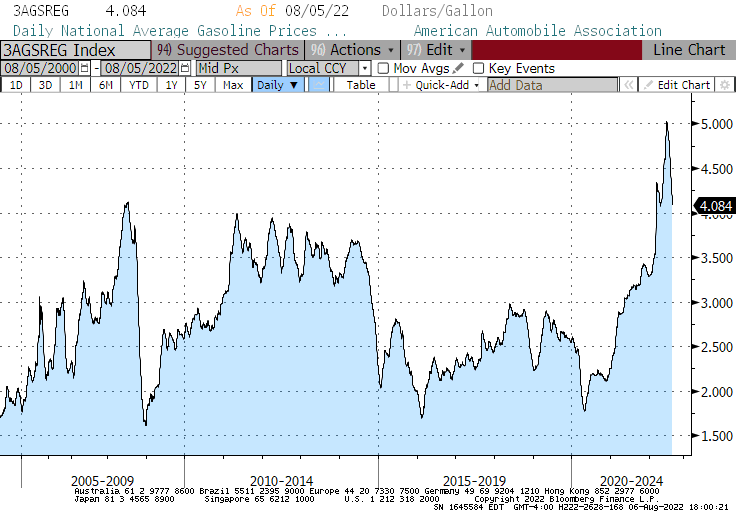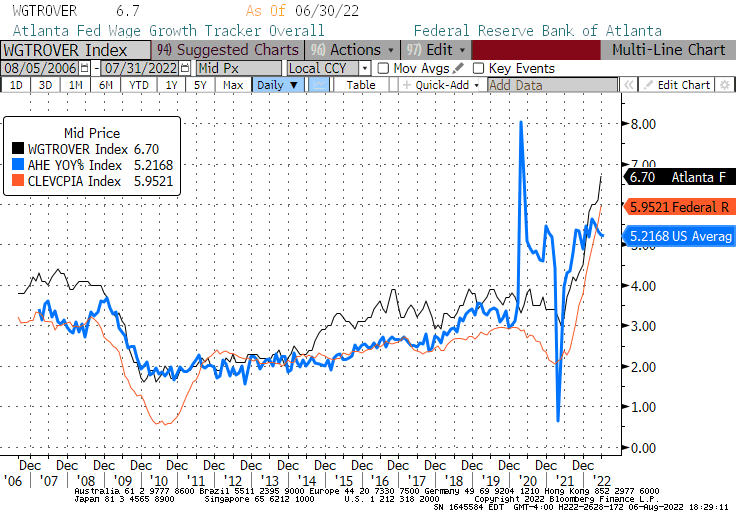- Money illusion has made the energy spike look worse than it is
- The CPI report is this week; Will median show any sign of peaking?
- Wages do not appear to be slowing at all.
Last week, I mused about whether calling the current state of economic growth a “recession” or not is relevant to anything. The answer is no—a thing is what it is, and a rose by any other name would smell as sweet.
This week, for totally different reasons, the answer came back “no, this clearly isn’t a recession.” Because, although we all know that it is true, you just can’t convince normal, well-adjusted people (that is, non-economists) that employment is a lagging indicator that you should never, ever look at for an indication about the future of economic growth.
And in this cycle, this is even more relevant since there is ‘pent up’ demand for labor, with job openings still very healthy relative to the number of unemployed, which argues that the lag time before the unemployment rate heads higher could well be longer than normal.
I stand by my view, which is that whether or not we are in a recession, we almost certainly will be at some point in the next year.
My analysis is simple, so I will repeat it: when interest rates and energy prices both rise sharply, we have never not had a recession.
I think you don’t need to be fancy unless you want to argue the reverse—that somehow, massive increases in the cost of energy and money won’t cause a recession. So, since I like to always look at the other side of the argument, let me point out how you might make sure an argument.
Energy prices have spiked. There is no debating that. But they haven’t really spiked as much as you think, because money illusion works very strongly on things you purchase frequently, like gasoline. Gasoline prices recently hit the highest level ever in the U.S., reaching $5/gallon nationwide.

Source AAA via Bloomberg
As I routinely point out, though, we have gotten very used to looking at prices in nominal terms and ignoring the slow drift lower in the value of a dollar. When inflation is low and stable, that is a decent shortcut. When inflation is not, such a shortcut causes misunderstandings. Here is the same chart, in constant 2012 dollars.
Source: Enduring Investments calculations, via Bloomberg
Notice that the left side of the chart, really up until about 2019, looks roughly the same whether you look at it in nominal or real terms. But the right side of the chart—which is when the price level started changing rapidly—looks drastically different. The high for gasoline, in 2012 dollars, wasn’t even $4/gallon.
That’s not cause for a victory lap, because it looks this way because of the collapse in the value of a dollar. Someone could argue, though, that this spike in energy prices isn’t as bad as it has seemed, in economic terms.
Naturally, the spike is even worse in visceral terms, because we give greater weight to small purchases that we make frequently even if the total spend is a relatively small part of the consumption basket. Gasoline is a classic case-in-point. From an economic impact standpoint, though, one could argue that the energy spike wasn’t as bad as it looked.
Similarly, although 2-year yields have risen from 0.12% at the end of 2020, to 3.22% today, that’s in the context of core inflation rising from 1.6% to 5.9%. Money is actually cheaper, after inflation, than it was 1-2 years ago.
So, perhaps it’s possible to skate by without a legitimate recession of the sort where people lose their jobs in bunches. I haven’t really succeeded in changing my own mind, though. My argument-by-foil would reduce to an argument that if you have enough inflation, it gets really hard to have a recession. And we know that not only is that false, it’s exactly backwards. Ergo, I continue to expect a recession (although I don’t think we are yet in one), accompanied with uncomfortably high inflation.
By the way, we tend to fixate on the number of net jobs in the employment report. But if a tight labor market combines with a slowing economy, then industry might be generating fewer new jobs yet also laying off even fewer. That would look like large payrolls numbers, but it wouldn’t be nearly as strong as if industry was actually creating lots of new jobs.
This was the most energy I have seen for a payrolls report in a while, but the inflation report this week is still the #1 data point for the month. Last month, Median CPI took the top off with a +0.73% month-on-month reading, fully 0.15% above its prior monthly high.
Remember, Median is the slow, stately one. It will probably not be as high this month, but it can’t yet be said to even look like it might be peaking. Core inflation will also re-accelerate this month, rising to 6% or 6.1% from 5.9% year-on-year. Headline will drop back below 9%, thanks to gasoline. I suspect that when Wednesday has passed, we will conclude that there is no reason for the Fed to take a victory lap, but that the report wasn’t quite as bad as people had been bracing for.
If I’m wrong, it will be because rents continued to accelerate and non-rent core services continued to take the baton from core goods. We aren’t close to the end of this inflationary episode, and I can’t even say that we are closer to the end than the beginning (we’d have to see Median peak, first), but it does feel like investors and central bankers are wanting to believe that it’s getting better. Fingers crossed.
Taking a Step Back…
As an inflation guy, I care more about the wages part of the employment situation. Average Hourly Earnings (AHE) in the payrolls report was steady at 5.2%, while it had been expected to decline. Guessing where AHE will print is really more of a party game than economic analysis. It’s a number that is so totally perverted by compositional effects as to make it worthless.
The chart below shows Average Hourly Earnings, in blue. Compare that to the black line, which is the Atlanta Fed’s Wage Growth Tracker (WGT). The WGT measures wage growth only for people who were employed at the beginning and the end of the measurement period so that the composition does not change over that period. And it behaves much more like the way wages really do. The bad news is that the WGT continues to spiral higher, staying just a little bit ahead of Median CPI.

Source: Bloomberg
Thanks to the Atlanta Fed number, there is little doubt in my mind that wage growth is continuing to accelerate, even if AHE looks like it might be peaking. If that’s the case, then the inflation expectations embedded in the market right now—which call for a complete collapse back to the Fed’s target over the next 6-12 months—are very wrong; also, the Fed’s notion that they are at, and soon will be above, the neutral short rate is also completely wrong.
However, I’m not sure the Fed will keep going until inflation gets all the way back to 2%. That would keep them tightening until late 2023, even if the market pricing of inflation is right. I think once core looks like it’s declining, they’ll stop. This means a few more meetings of hikes, probably.
Then again, I’ve been very wrong on the Fed so far.
Disclosure: My company and/or funds and accounts we manage have positions in inflation-indexed bonds and various commodity and financial futures products and ETFs, that may be mentioned from time to time in this column.
